Posted by: Ken @ 12:14 pm
The first time I heard a Florida birder talk about finding birds in a certain “hammock,” I almost wanted to correct him. Up east, the only hammocks I knew were made of canvas and slung between two posts. I thought he meant to say “hummock,” a word that I first heard used by a farmer, who pointed to a hill out in the middle of his hayfield that was too steep to mow and had gone over to shrubs and trees. Of course, I’ve since learned that “hammock” has a very specific meaning in any discussion of Everglades ecology.
From the ground, a hammock indeed looks like a “hummock,” a tree-covered hill that rises high above the surrounding Sawgrass prairie. Hammocks are scattered throughout the Everglades, but they are actually quite level, and only a foot or so above the high water mark. It is the trees themselves that rise up in a graceful mound. In the dry soil, hardwoods of many kinds flourish, draped with ferns and air plants: mahogany, oak, maple, hackberry and gumbo limbo, as well as native palms. Cocoplum, commonly used as a hedge or small shrub in residential neighborhoods, grows to tree size. Hammocks serve as refuges for more terrestrial creatures such as bobcats, panthers and raccoons.
It can be quite cool in the deep shade of a hammock. My only experience in walking through a hammock has been on trails in Everglades National Park. In my neighborhood, the land has been drained and filled, and hammocks are long gone. However, I did find a very lame imitation of a hammock at the edge of our subdivision, where for some unknown reason, the landscapers have allowed trees and shrubs to grow undisturbed.
Here is our little “faux hammock.” Cool and surprisingly not very buggy, it sometimes harbors migrating warblers, vireos and tanagers:
The trees are mostly exotic and invasive Brazilian Pepper, a species introduced and popularized as “Florida Holly” because of its bunches of red berries.
A Blue-gray Gnatcatcher perches on a clump of Brazilian Pepper berries. The thick leathery leaves smell like turpentine when crushed: 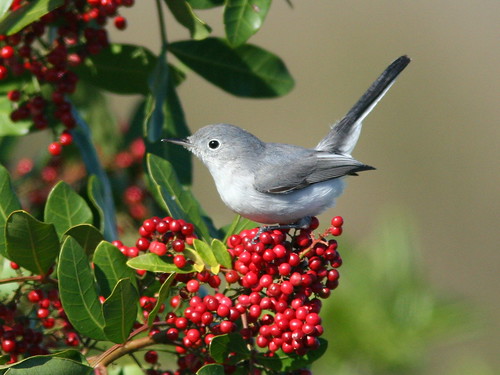
Other fruit-producing trees and shrubs I have found in this spot include ligustrum and lantana species, as well as several native Florida Trema (Trema micranthum), - a weedy pioneer tree that is a popular food plant for migratory birds. I discovered that this type of tree was particularly important to the birds that visit here. Hundreds of catbirds were passing through, and they helped clean up the ripe Trema fruit, as the tree continued to produce new green berries.
The berries of the Florida Trema grow in clusters along the stems rather than hang in bunches; its leaves are thin and soft:
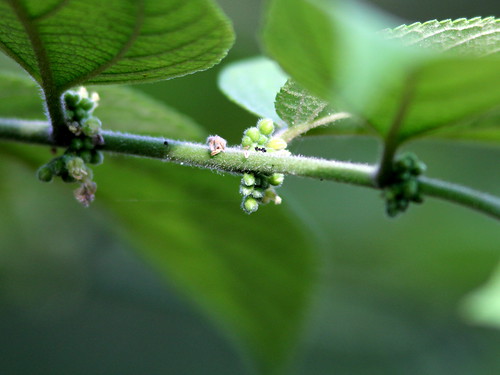
This past week we finally had an influx of spring migrants. Here in Florida, spring just sort of creeps up on us just about when we need to turn on the air conditioning and the nights become too hot to sleep with the windows open. As is our habit, Mary Lou and I begin our morning exercise at dawn by walking the unpaved road that leads into the wetlands preserve next to our home. On our way back, after visiting the large lake about a half mile in, we stop at our “hammock,” where I tend to linger and hope for killer photos of birds, sankes, alligators, Bobcats… anything that moves and many things that don’t. Although she is great about putting up with my frequent stops, I understand when she runs out of patience and wants to keep walking.
Previously, we always birded our “hammock” from the outside, but this year I ventured into the depths of the trees and shrubs and was surprised to find quite a nice open area beneath the dense canopy:

Standing quietly in the shade for over an hour at a time, we let the birds come to us. Some look down quizzically to find out who is invading their territory…
…including this Gray Catbird (note the green unripened Trema berries):
…a Common Grackle collecting food for nestlings:
…a White-winged Dove perched in the Trema:
…and a normally timid Common Ground-Dove, a species that never before permitted me to get so close:
Warblers, the stars of the show, paraded before our eyes, strangely silent. Up in Illinois they often sing as they approach their northern destinations, but here in Florida the most I hear from them is an occasional call note: “chip.”
Our first visitor was a male Black-and-White Warbler:
A male Black-throated Blue Warbler plucked a Trema berry:
An American Redstart never sat still more than two seconds, so most of my attempts to photograph it resulted in empty branches. Only after I got home and reviewed my shots did I find this single full-body image: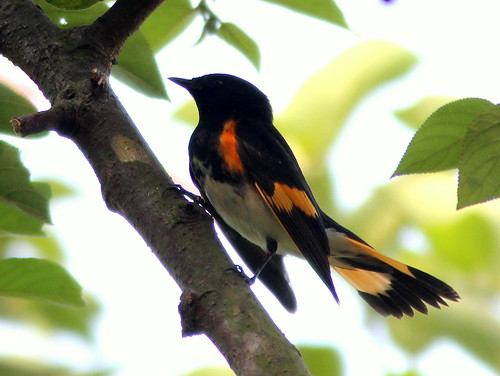
I spent nearly a half hour trying to get an unobstructed view of a male Blackpoll Warbler, to no avail. Mary Lou got tired of watching me and walked home. After I gave up the chase, it came to me and posed nicely:
While it is considered to be one of the “confusing fall warblers,” the female Blackpoll is quite distinctive in spring:
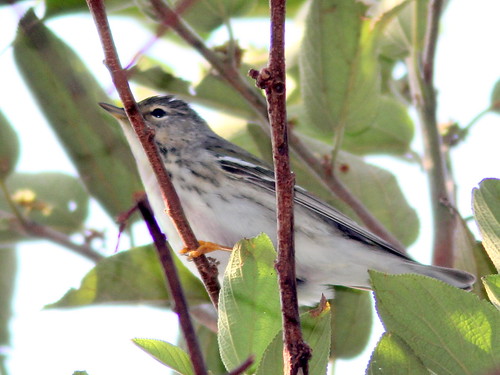
A male Cape May Warbler provided a splendid view, and Mary Lou can only blame herself for missing it:
A female Cape May Warbler was harder to keep in my viewfinder as it gobbled down the Trema berries:
This was the best portrait I could obtain of a Prairie Warbler:
As a side note, I found it interesting that the old dried Trema berries developed some kind of white powder on them– whether it was powdery mildew or possible scale insects, I don’t know. This past winter, a Prairie Warbler got the white dust on its bill as it foraged among them (Photographed at same location, February 4, 2011):
A Blue-headed Vireo paid a brief visit…
…as did a Least Flycatcher, a species not commonly seen here during spring migration:

A male Northern Cardinal offered me a lucky shot in between the branches of the Trema (note how the berries grow along the stem and ripen at different times, providing a steady supply of food):
It was impossible to overlook the butterflies. Here, a Zebra heliconian sips nectar from a pink Lantana flower: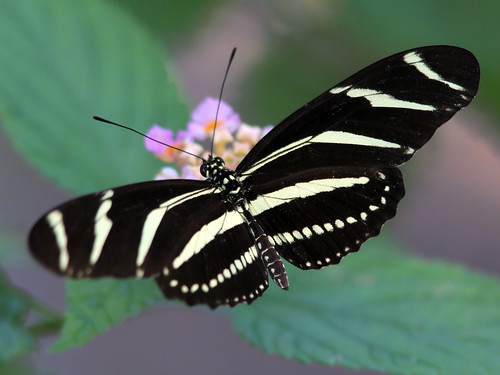
The shaded Lantana bear pink flowers, while those in full sun tend to be orange, red and yellow. A Julia heliconian visits a Lantana that reaches above the canopy, over 20 feet tall: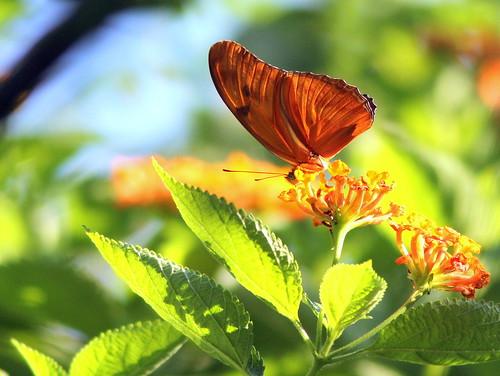
Rustling in the leaves underfoot reveals a Brown Anole that scurries up a stem to display his dewlap to a rival: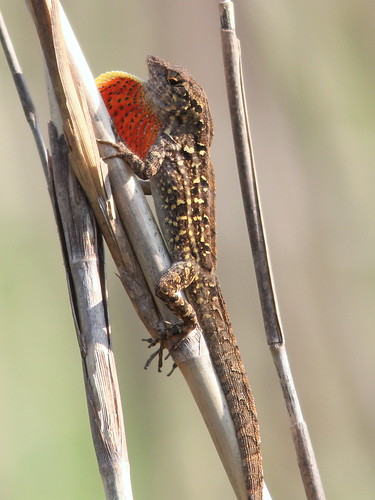













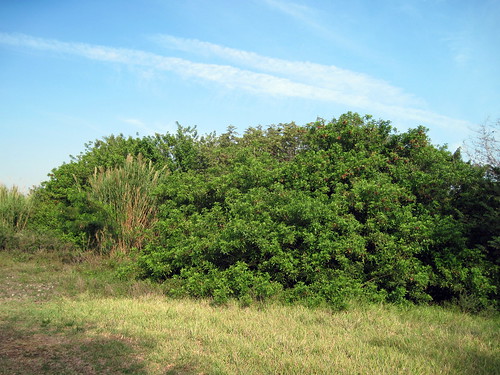
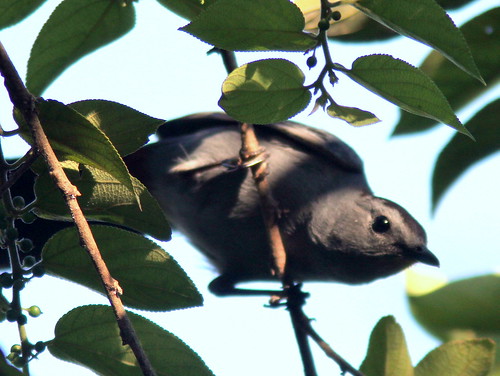


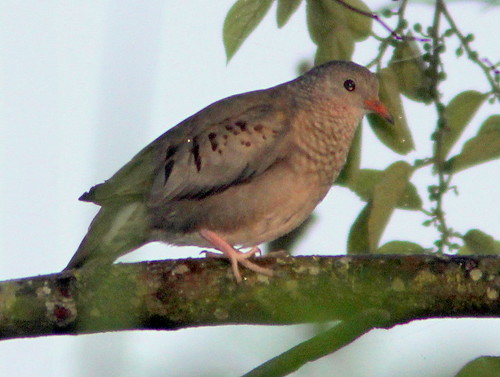
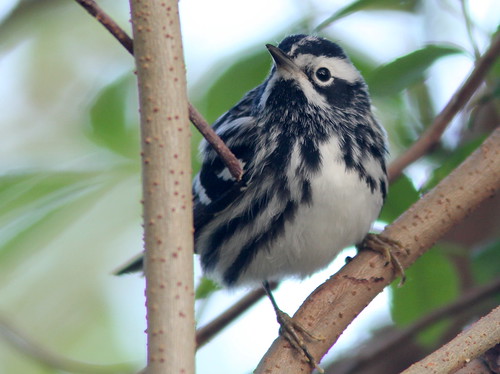
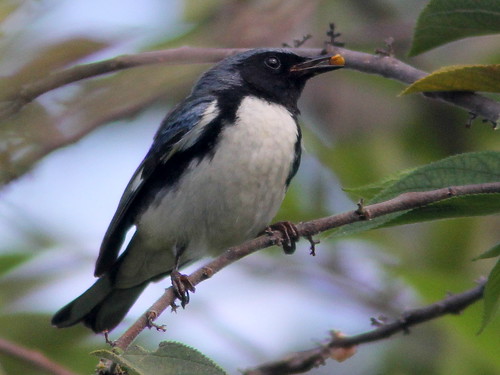

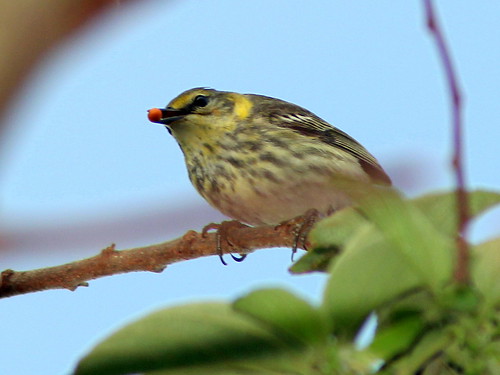
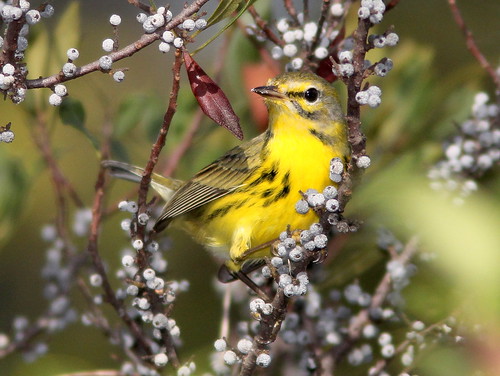
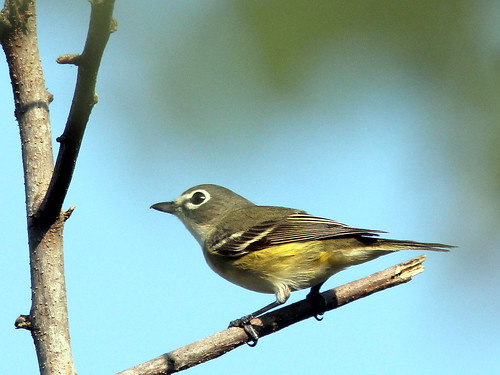
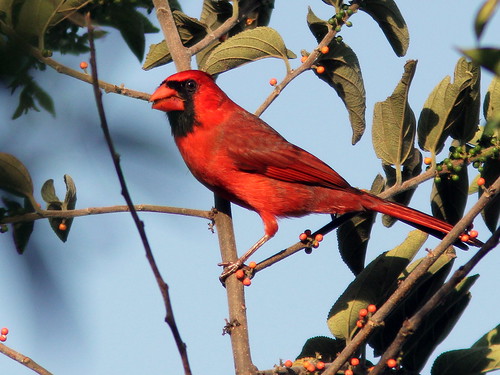
April 16th, 2011 at 4:34 pm Excellent treatment of the subject Ken as well as cool photos. Wish we had some of your migrants over here in Collier county!
April 17th, 2011 at 3:15 pm That is a glorious collection from inside your ‘hammock’ Ken.
April 19th, 2011 at 2:11 pm Lovely series of beautiful birds. Many thanks for sharing.
April 19th, 2011 at 2:54 pm A great series of photos and the description of the Hammock is very interesting.
April 19th, 2011 at 3:01 pm All awesome captures. Love the Gnatcatcher!
April 19th, 2011 at 4:25 pm Oh my, What a visual feast. One delightful image after another. What a time you had. Is a gnat catcher related to what I know as the spotted flycatcher? I really enjoyed this lovely series.
April 19th, 2011 at 5:40 pm The shot of the bird on the berries is striking…watch out for that grackle. I think you annoyed him :)
April 19th, 2011 at 5:59 pm An epic post!The photographs are detailed and interesting in composition. Your patients really paid off. The time it takes to develop a post like this can hardly be appreciated. Thank you for sharing the story of your magical time in the hammock. It is the stuff dreams are made of!
April 19th, 2011 at 9:13 pm Great pictures and an interesting post. I love the picture of the red-start.
April 19th, 2011 at 10:05 pm Your photos are excellent and such a collection! What a wonderful birding site your “make-believe hammock” is!
April 20th, 2011 at 8:23 am Beautiful series of photos!! Boom & Gary of the Vermilon River, Canada.
April 20th, 2011 at 3:09 pm JEEPERS— What an amazing array of warblers and song birds and just about every other kind of bird. IM Green with Envy and the info on the hammock was very interesting..seems that one landscape/developer has done a wonderful thing for the homeowners–WE could all learn from that–its all about habitat creation and protection!! ^5
April 21st, 2011 at 3:06 am OMG,These photos made my jaw drop,and get stuck there! AWESOME!
April 21st, 2011 at 3:57 am Wow, awesome shots of all the warblers. And I love the first Catbird shot. Great post and photos.
April 21st, 2011 at 9:44 am Thank you, all. @ jocodeane– the Old World Flycatcher family, which includes the Spotted Flycatcher, does not have any representatives in North America. Our gnatcatchers are also in the same large group of songbirds, but are not closely related.
April 24th, 2011 at 12:42 pm My goodness- those are some amazing shots of birds I don’t get to see here. Thanks!